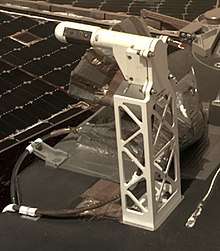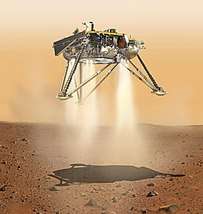Temperature and Winds for InSight
Temperature and Winds for InSight (TWINS) is a meteorological suite of instruments on board the InSight lander that landed on Mars on 26 November 2018. TWINS will provide continuous wind and air temperature measurements to help understand the seismic data from the SEIS instrument. The instruments were developed by the Spanish Astrobiology Center at Madrid, Spain.
 A TWINS sensor | |
| Operator | NASA / JPL |
|---|---|
| Manufacturer | Spanish Astrobiology Center (CSIC-INTA) |
| Instrument type | Atmospheric sensors |
| Function | Meteorology suite |
| Mission duration | 2 years |
| Began operations | Landing: 26 November 2018 |
| Host spacecraft | |
| Spacecraft | InSight |
| Operator | NASA / JPL |
| Launch date | 5 May 2018, 11:05 UTC |
| Rocket | Atlas V 401[1] |
| COSPAR ID | 2018-042A |
Overview
TWINS is based on the heritage from REMS (Rover Environmental Monitoring Station) on board the Curiosity rover, with enhanced performances in terms of dynamic range and resolution.[2] TWINS will provide continuous wind and air temperature measurements to help understand the seismic data from the SEIS instrument.
While probing the internal structure of Mars is the primary scientific goal of the InSight mission, atmospheric science remains a key science objective.[3] InSight will provide a continuous and higher-frequency record of pressure, air temperature and winds at the surface of Mars than previous in situ missions.[3]
The sensors include thermometers, and an anemometer to measure wind speed and direction twice per second. Additional sensors are the InSight FluxGate (IFG) magnetometer provided by UCLA to measure the direction and magnitude of magnetic fields such as those caused by the Martian ionosphere; and a highly sensitive pressure sensor (barometer) from JPL.[4][5]
Wind, temperature, pressure and magnetometer data will be used to understand the local wind behavior at the landing site to help understand and interpret SEIS data.[6] At the same time, the lander will use its cameras to document cirrus clouds that develop high above Elysium Planitia, any instances of fog that appear along the ground, as well as dust devils.[7] With this data, scientists will be able to gain even greater insights into Mars' weather and climate, supplementing what was collected by previous missions, and what is currently being gathered by the Curiosity rover about 600 km to the south.[7]
Auxiliary Payload Sensor Suite (APSS)
TWINS on InSight is part of what is called the Auxiliary Payload Sensor Suite, forming a "weather station" which components include:[6]
- TWINS: Temperature and wind sensor developed by the Spanish Astrobiology Center (CAB), Madrid, Spain.
- IFG: InSight FluxGate magnetometer, developed by the University of California at Los Angeles (UCLA) ay USA
- PS: Pressure sensor developed by the TAVIS company at USA
- PAE: Electronics controlling the TWINS, PS and IFG sensors developed by JPL.
References
- Clark, Stephen (19 December 2013). "Mars lander to launch from California on Atlas 5 in 2016". Spaceflight Now. Retrieved 20 December 2013.
- The TWINS Instrument On Board Mars Insight Mission. Velasco, Tirso, and Rodríguez-Manfredi, Jose A. EGU General Assembly 2015, held 12–17 April 2015 in Vienna, Austria. id.2571. April 2015.
- Atmospheric Science with InSight. Spiga, A., Banfield, D., Teanby, N.A. et al. Space Science Reviews. 2 October 2018. 214:109 doi:10.1007/s11214-018-0543-0
- David, Leonard (15 August 2014). "NASA's Next Mars Lander Will Peer Deep Into Red Planet's History: Here's How". Space.com. Retrieved 16 August 2014.
- Banerdt, W. Bruce (7 March 2013). InSight: A Geophysical Mission to a Terrestrial Planet Interior (PDF). Committee on Astrobiology and Planetary Science. 6–8 March 2013. Washington, D.C.
- Operations of the SEIS Seismometer Onboard the 2016 Mars InSIght Mission. Charles Yana, Aurélie Moussi, Agnès Jullien1. SpaceOps Conferences. 16–20 May 2016, Daejeon, Korea doi:10.2514/6.2016-2592 Copyright by CNES. Published by the American Institute of Aeronautics and Astronautics, Inc., with permission.
- NASA InSight to give us our best look yet at Mars weather. The Weather Network. 22 November 2018.

